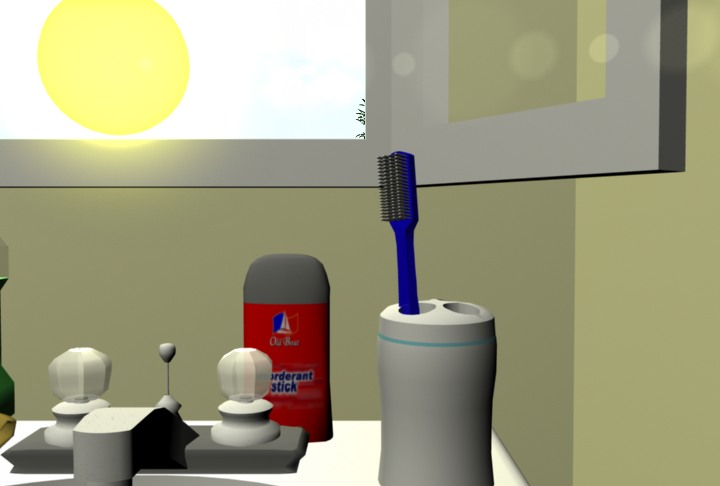Okay so I created a 3-D animation using maya. Ive decided to re-render it to stills so I can continue to edit the movie using video editing software, Pinnacle Liquid Edition v6. My end goal is to produce a polished looking DVD with the crispest of video quality. I was wondering what image resolution I should render out my frames to. After some research, I found that 720x480 @ 29.97 fps is one of the DVD standards for NTSC.
Should I go ahead and render my still image frames to this size?
After a few test imports, editing, and then outputing to a DVD compliant MPEG2 file I noticed that the fine detail of my animation is a little odd. The best way I can describe it is the sharp corners "twiddle" with motion. How can I fix this?
I should also add that my animation short is only about 2 and a half minutes, so DVD space is abundant.
My program route will be:
Maya output stills -> Liquid Edition edits, then uncompressed AVI output -> TMPGEnc for DVD encoding.
*the image included is a still frame rendered from Maya at 720x486 (the 486 was intentional, i was playing around with the MiniDV standard resolution)

+ Reply to Thread
Results 1 to 5 of 5
-
-
If you are rendering for NTSC I would either render progressive frames at 23.976 fps, or interlaced frames at 29.970. I don't believe you can have NTSC progressive DVD at 29.970.
Because you haven't gone for a realistic look, and have very crisp, sharp CG edges, you will, as you have discovered, run into interlacing issues. Namely flicker on the horizontal edges.
You should also look into the motion blur attributes of your renderer, as this will add to the smoothness of the motion, and hide some of the interlacing problems.
I would also suggest strongly you spend some time in dedicated 3d forums such as 3dbuzz.com before you commit, as you will get better advice on 3d work there.Read my blog here.
-
Seriously, you want it to look like a good film right? Then, set it for film resolution (HD, 2k or 4k, @ 24fps progressive, RGB or 4:4:4 YUV or maybe 4:2:2 YUV, 8bit/color--12bit/color) and then resize & encode together. Rendering'll be a bear as well as file sizes, but your quality will look very good.
Even if you don't want to "keep" it at this size, one thing you'll be doing with the resize during encoding is in essence "Oversampling", which will greatly help with the sharpness/smoothness/diagonals and somewhat with the dynamic range.
The "motion blur" idea is a very good thing if used very sparingly.
Scott -
I would also like to add..
(this is assuming that your images are in RGB color space to begin with)
That once you go MPEG, you do loose a little detail, in terms of sharpness.
But this in on account of the sampling that takes place during the MPEG
encoding process, when the source video image goes through a slight trans-
formation, YV12.
I would also suggest that if you are still doing other work with these image
sources, that you keep it inside your RGB color space, until you are ready
for the final MPEG, because the end result requires some conversions:
** RGB->YUV->YV12
When you transfer your hard work to MPEG, the process intails throwing out
some pixels, and that could be your unfortunate experience so far.
Also, if you going to do any resizing, that you do so inside your RGB color
space, before any conversion taint the image.. (other than Cornucopia's suggestion)
In other words, if your end goal is DVD, and since the dvd spec requires a
resolution of 720 x 480, that you resize to this resolution. But, better
yet, design your images starting with 720 x 480 to begin with, and no taint
will need be worried about.
If you could upload a few of your clean pics 720 x 480 (untouched) so we can
have a closer look, that would be awsome!
-vhelp 3978 -
Wow you guys are the best. Thanks a ton. I'm especially glad someone mentioned the motion blur, I completely overlooked that as a possible problem. With the summer here I have nothing but free time. So I'll be experimenting with re-rendering and dvd specs til I get my desired results. If you guys would like, I do have the version of the short my group presented in our animation class on myspace: http://vids.myspace.com/index.cfm?fuseaction=vids.individual&videoid=754600680&n=2
Once again, thanks for the responses! [/url]
[/url]
Similar Threads
-
Feedback On Intro Desired
By budwzr in forum Newbie / General discussionsReplies: 11Last Post: 23rd Dec 2011, 15:49 -
Converting DVD Movies to the iPod WITH Desired Subtitles
By jsegovia in forum Video ConversionReplies: 1Last Post: 18th Jan 2010, 08:01 -
How to Fit 3 movies on 1 DVD 4.7GB and keeping high resoultion and quality?
By Virius in forum Authoring (DVD)Replies: 4Last Post: 8th Aug 2009, 15:12 -
Xvid 8 bit color depth resoultion problem
By afcoff in forum Video ConversionReplies: 4Last Post: 23rd Feb 2009, 23:50 -
DV to H.264 Resoultion Question-> 480x360 or 480x320???
By tarrickb in forum Video ConversionReplies: 1Last Post: 8th Aug 2008, 18:13



 Quote
Quote